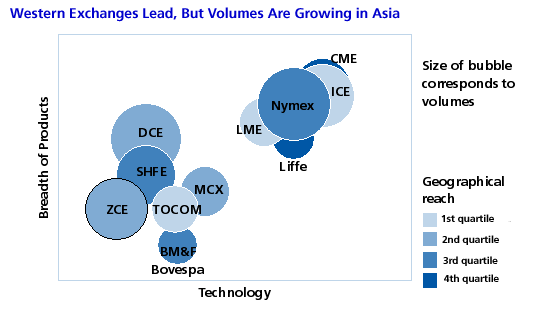Commodity Exchanges: Consolidation Drivers and Implications
Abstract
Commodity derivatives have been a growth market in the financial world. The pace of consolidation has quickened among trading platforms such as exchanges and interdealer brokers in the last two years. Along with the increasing importance of clearinghouses due to counterparty risk, drivers of consolidation such as geographical expansion, liquidity acquisition, and technology are expected to play a role in exchange development.
In this report, Commodity Exchanges: Consolidation Drivers and Implications, Celent analyzes the development of the leading global commodity exchanges. A wave of consolidation created larger entities such as the CME Group and ICE in the West. It is expected that exchanges such as CME Group, which deals in all segments of the commodity markets, will fare better than exchanges that deal in a single segment such as agriculture or metals.
The Western exchanges lead a global comparison on the basis of greater breadth of products and better technology. While the Asian exchanges are more basic, exchanges such as DCE and MCX have much higher growth rates because they serve the fast-growing economies of China and India (e.g., DCE grew almost 70% in 2008).

"Commodity exchanges will see major changes as they cope with the aftermath of the economic downturn. Volumes will suffer initially, but they are expected to benefit from the OTC business moving to exchanges, due to lower counterparty risk," says Anshuman Jaswal, Celent analyst and author of the report.
This is the first in a series of three reports that look at the trading platforms and clearing houses in the commodity markets. This report informs the reader about the major global commodity exchanges and analyses the reasons for industry consolidation that has taken place in the last few years. The increasing overlap between exchanges and the interdealer broker market is also discussed. The latter will be studied in greater detail in the second report in the series, with the final report looking at the crucial role of clearinghouses in the marketplace.
This 70-page report contains 35 figures and 10 tables. A table of contents is available online.
Members of Celent's Commodities research service can download the report electronically by clicking on the icon to the left. Non-members should contact info@celent.com for more information.

